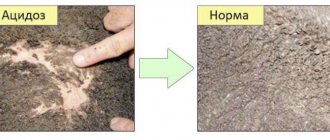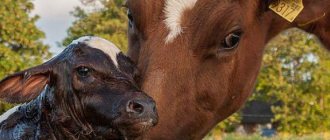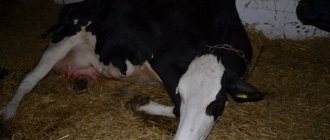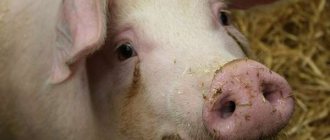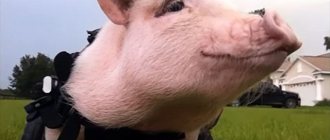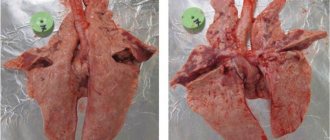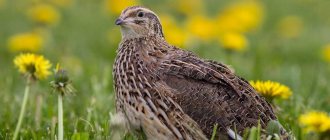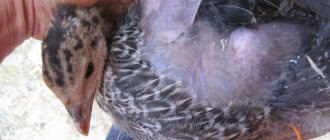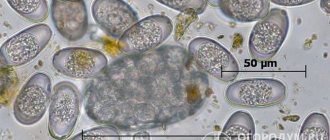Reasons for staleness
- During childbirth, there is a high risk of injury to ligaments, bones and joints, therefore the main reasons for laying in cows are considered to be:
- Sprained ligaments and joints of the pelvic area.
- Fractures of the pelvic bones.
- Development of the inflammatory process in the muscle fibers of the limbs and pelvis.
- Infringement of the sciatic, obturator nerves.
- Incorrect assistance to a cow during the birth of a large calf.
Let's consider what manifestations this postpartum pathology has:
- The cow cannot get to her feet, and if she raises her body, it is only for a short time, then she falls again.
- The back of the body and limbs are weakened.
- The sensitivity of the legs is preserved.
If the cause of the deposition is fractures, then upon examination of the animal, characteristic compactions, swelling or displacement at the site of injury can be detected. At the same time, the limbs are painful - when you touch them, the animal becomes worried and moos.
Attention! It is important to ensure that sensation in parts of the body is preserved. This can be checked with a needle or pin. If the cow does not feel pain, then we are no longer talking about lying down, but about paralysis, which develops due to hypocalcemia or for other reasons.
Reasons for deposition
Pregnancy and childbirth affect the animal's body. Stagnation begins both a few days or weeks before birth and after. In cows preparing to give birth in the summer, prenatal laying is a rare occurrence. Basically, cows that are ready to calve at the end of winter are subject to prenatal laying. If a cow lies low before giving birth, then most likely she will not get back on her feet after calving.
Delay before childbirth is due to several reasons:
- unbalanced and insufficient feeding during pregnancy;
- lack of walks;
- insufficient space that limits the animal’s activity;
- smooth, sloping floor;
- crowded conditions with poor ventilation and sanitation;
- a large fruit that compresses the nerve plexuses;
- inflammatory diseases: arthritis and myositis;
- hypothermia of the body.
It happens that a cow spent her entire pregnancy on her feet, but after calving she cannot stand for a long time. This phenomenon is called postpartum retention, the causes of which are:
- hypocalcemia;
- fracture of the pelvic bones during childbirth;
- injury in the first hours, when the cow does not understand what is happening to her and tries to get up, injuring herself and damaging ligaments;
- tearing of soft tissue fibers;
- pinched nerves;
- compression of the sciatic and obturator nerves (pinching);
- difficult childbirth;
- unqualified assistance during the delivery of a large calf.
If a cow does not get up after giving birth, but looks healthy and takes food, then this is due to a weakening of the musculoskeletal system.
Diagnostics
The diagnosis is made by a veterinarian based on data obtained after a thorough examination of the cow. Visual and manual examination allows you to exclude or confirm traumatic causes of retention. If none are found, more serious pathologies of the animal’s health are suspected - metabolic disorders, infectious diseases, postpartum complications, internal inflammatory processes. The treatment regimen directly depends on the diagnosis.
Simple retention is treated symptomatically. Particular attention is paid to the conditions of keeping a sick cow. She needs to be provided with clean soft bedding, a warm and dry room with good ventilation. When lying around, bedsores often form, which, if not properly cared for, can lead to inflammation and even necrosis of soft tissues. To avoid this, the animal must be turned over several times a day. The body, especially the back part, needs to be rubbed to improve blood circulation.
For rubbing use:
- Camphor oil.
- Mustard alcohol.
Warming bandages or applications are applied to the sacral area. The cow needs to be raised at least 1-2 times a day. This is done using ropes. Sometimes it is enough to lift the back of the body for the animal to stand on its feet.
The animal is provided with adequate nutrition, including vitamin and mineral supplements. If more serious health pathologies are detected, drug treatment is prescribed, including:
- Anti-inflammatory drugs.
- Antibiotics.
- Painkillers.
- Antispasmodics.
Attention! If cows are kept for a long time, their intestinal function may be disrupted, as evidenced by rumen swelling and lack of bowel movements. Report this problem to your veterinarian.
Why doesn't the cow get up on her feet?
The anatomy of cattle is such that when rising from a lying position, they first straighten their hind legs and only then their front legs. If the animal cannot lift its hindquarters, it remains lying down. Usually, when a cow's hind legs fail, the owners first assume postpartum paresis. In most cases they are right, but sometimes a cow can fall on her feet long before calving or several months after it. Sometimes even in young bulls taken for fattening, the legs begin to fail. There is no way to attribute this to calving.
In addition to metabolic paresis, the most common reason is that cows begin to have problems with the musculoskeletal system. An animal can fall on its feet as a result of the development of:
- hypovitaminosis E
- lack of selenium;
- white muscle disease;
- lack of phosphorus;
- ketosis;
- rickets;
- arthritis.
In poor conditions, many cows may fall on their feet due to joint inflammation or hoof problems. If the imbalance of the diet does not always depend on the owner, then the maintenance is entirely on his conscience.
With metabolic disorders, the lack of one element causes a chain reaction in the body. A cow cannot fall on her feet simply due to vitamin E deficiency or selenium deficiency. But this entails the development of white muscle disease, as a result of which the animals’ muscles refuse to work.
Comment! It is the lack of vitamins and minerals that is the most common cause of falling on their feet in very young cows.
If a calf develops rickets due to a lack of vitamin D, then an adult cow develops osteomalacia. The latter can also only be a symptom of hypophosphatasia, a genetic disease.
Cows give off a lot of calcium through their milk. She “takes” it from her own bones. Even if the owner tries to replenish this element to his nurse, the calcium content still decreases with age. A lack of metal in the bones leads to changes. And a sign of age-related calcium deficiency is that the cow begins to have difficulty standing on her hind legs. Over time, the problem worsens, and the animal can no longer stand at all.
Among the more exotic reasons why a cow does not stand on her hind legs is the pressure of the fetus on the nerves in the sacrum. During deep pregnancy, the fetus in the uterus can press on the rump of a lying cow from the inside.
Calves may collapse if suddenly switched from a dairy diet to roughage. In this case, the book becomes clogged with grain, and sometimes with soil, when the animal tries to eat grass. This often happens in bulls taken for fattening, which are purchased at 2-3 months of age. Since their gastrointestinal tract is not yet developed, the calf is not able to digest grain. A clogged book causes pain and a desire to lie down. Then the cub weakens and dies.
The most rare case of foot problems in cows is unkempt hooves. Even city dwellers almost all know that horses need to be shoed and their hooves taken care of. But for cows and small livestock this moment is very poorly covered. However, their hooves also need to be looked after. Cows also need to be trimmed every 3 months. Otherwise, the overgrown hoof wall may curl inward and begin to put pressure on the sole. If a stone gets between them, it will cause a lameness very similar in appearance to osteomalacia. Since being napped is very painful, the cow gets to her feet poorly and reluctantly, preferring to lie down.
Sometimes the reason a cow falls on its feet is due to neglect of hoof care.
White muscle disease
This is a metabolic disease that affects young animals up to 3 months old. It occurs as a result of a lack of a whole complex of elements, but the leading link is a deficiency of vitamin E and selenium. The disease develops gradually, and lifetime diagnosis is always presumptive.
Since the calf weakens slowly, the owner may not pay attention to the animal's discomfort. The owner comes to his senses only after the young animals have already fallen to their feet. At this stage, treatment is useless and the calves are sent to slaughter.
In the early stages of the disease, animals are provided with high-quality feed with plenty of vitamins, and injections of the missing elements are carried out.
Comment! What exactly is missing in the “standard” diet is determined in the laboratory using an analysis of the chemical composition.
Vitamin E is prescribed intramuscularly. Course 4 days 1-2 times a day. For the next 5 days, inject every other day at a rate of 3-5 mg/kg body weight. Then - once a week at the same dose as the previous course.
Phosphorus deficiency
A cow may fall on its feet if there is a lack of phosphorus. But the element itself will not be “to blame” for this. Its deficiency entails a whole chain of metabolic changes. Cattle can stand on their feet, but prefer to lie down; the joints on their limbs become enlarged. The position changes: the cow crosses her front legs.
It is difficult to correct the balance of phosphorus in feed using feed phosphates. In Russia, only two types of premixes are produced: defluorinated phosphate and monocalcium phosphate. They are not suitable for dry cows that require a low calcium to phosphorus ratio. These premixes are of little use for ruminants during other periods of life. Cattle do not have enough hydrochloric acid in their stomachs to extract phosphorus from calcium phosphates in the feed.
You can look for tricalcium phosphate produced in Kazakhstan for sale
Ketosis
To put it simply, this is protein poisoning. Caused by an excess of protein feed in the diet. In mild cases, the cow exhibits a perversion of appetite and signs of intoxication. When severe, depression sets in and animals prefer to lie down.
The owner often believes that a cow in ketosis has fallen on its feet, although it can be made to stand up. But if the disease develops after calving, then protein poisoning is often mistaken for postpartum congestion or paresis. Treatment carried out in the event of an incorrect diagnosis is expectedly unsuccessful. The definition of “fell on its feet” in this case means that the animal has not lost its hind limbs, but it is simply difficult for it to stand. And when rising from a lying position, the cow does not have normal support.
Rickets
The most well-known disease of young animals caused by a lack of vitamin D and exercise. But in order for a calf with rickets to “fall on its feet,” you have to “try hard.” Usually, with this disease, young animals are stunted in growth, and also develop a barrel-shaped chest and crooked limbs.
With rickets, not only the bones soften, but also the ligaments. As a result, the fetlock joints often “sag” very much: on the hind limbs they “sink”, and on the front limbs the picture looks like contracture.
Lack of phosphorus, or more precisely, its incorrect ratio with calcium, is the main cause of the development of bone diseases
Osteomalacia
In part, it can be called the “adult” version of rickets. It also develops with a lack of vitamin D and insufficient exercise. But cows have another reason for the development of this pathology: milk. Dairy cattle release too much calcium from their bones.
With osteomalacia, bone volume increases but bone density decreases. Bone tissue becomes soft. The first sign of calcium leaching is softening of the tail vertebrae. Ligaments also lose their shape. Gradually, it becomes difficult for the cow to stand and move. Similar signs are observed in older animals, even those with a nutritious diet and good living conditions. Especially among high-yielding ones.
If an older cow falls on her feet, veterinarians usually advise giving her up for meat and not suffering. The average lifespan of dairy cattle is 8 years. This is the price for large milk yields.
Attention! There is no cure for osteomalacia.
The process can only be slowed down. This is why there is no point in trying to raise an old cow.
Prevention
Prevention of postpartum retention includes the following measures:
- Organizing a nutritious diet during pregnancy.
- Providing normal living conditions for animals.
- Quality walking.
- Adequate qualified assistance during calving.
- Timely preventive veterinary diagnostics during pregnancy and after childbirth.
Leaving a cow during the period after calving requires mandatory human intervention. A weakened animal needs veterinary care. If it is not provided in a timely manner, even more serious complications will arise. It is necessary to invite a veterinarian if symptoms of deposits are detected and strictly follow his instructions.
Types of metritis
Experts divide the disease according to the place of infection:
- Endometritis - mucous membrane.
- Myometritis is medium muscle tissue.
- Perimetritis - serous lining of the uterus.
This division is arbitrary, since infection always begins with the mucous membrane, and then spreads to the rest of the organ, spreading toxins throughout the cow’s body.
There are several types of disease, divided by characteristic features.
- Catarrhal variety. The description may vary depending on the form of the disease, but it is very difficult to diagnose because it quickly develops into more serious pathologies. There is a general deterioration in the animal's condition, an increase in temperature, and a decrease in appetite.
- Purulent. Usually indicated on the second day after giving birth, the cow regularly gets into a position as if to urinate, but nothing happens. Even when lying down, a viscous, foul-smelling fluid is released from the genital tract. Upon examination, it is revealed that the uterus is larger than usual.
- Fibrous. The cow with this variety does not feel bad and eats normally. But films with yellowish deposits form on the walls of the uterus. Deterioration begins abruptly, affecting the entire body.
- Necrotic. Associated with damage to tissues, muscles, and blood vessels during difficult childbirth. An inflammatory fluid enters the wounded mucosa, blocking the normal flow of nutrients. The walls of the uterus may not withstand such pressure and rupture, which will lead to new wounds. At this time, the cow’s temperature rises significantly, appetite decreases, severe diarrhea and paralysis are observed.
- Hemorrhagic. Characterized by hemorrhage into the mucous membrane, vascular thrombosis. Accompanies other infectious diseases.
Endometritis
Its appearance depends on the nature of labor in cattle:
- Lungs - the calf is born on its own - the disease is observed in a small number of cases.
- Medium - livestock breeders help the cow give birth - the percentage of occurrence of violations is higher.
- Severe - the process takes a long time, often involves surgical intervention - almost always ends in endometritis and infertility.
Among the signs of the disease are:
- A small amount of milk.
- Depressed state.
- Mucous, purulent discharge from the uterus.
- There may be bleeding in the vagina.
- The uterine horns swell and increase in size.
- The cow is eating poorly or not eating at all.
To avoid possible infertility, a long-term set of measures is carried out to improve the health of the animal. The main task of the livestock breeder at this stage is to increase the cow’s immunity and get rid of all kinds of infections and damage.
Myometritis
It is a more severe form of endometritis, characterized by a general deterioration in the condition of the affected livestock. At the same time, an infection enters the walls of the uterus, they become denser and thicker. When palpated, irregularities and bumps become noticeable. In places, deposits of lime salts occur, which leads to the formation of ulcers and abscesses. The motor function of the organ is completely reduced. Unfortunately, this type of metritis is difficult to cure and often ends in infertility.
Perimetritis
Another option for complications of endometritis, which occurs due to direct injuries to the uterus, its cervix or vagina. In these cases, the infection is able to reach the serous layers, which leads to complete infection of the animal.
Main symptoms:
- Poor general condition.
- The lymph nodes in the pelvic area are enlarged.
- The tissues near the uterus harden and have an uneven structure.
- The organ itself is painful and sensitive.
- Rectal examination reveals the presence of adhesions.
- The inflammatory process quickly spreads into the abdominal cavity.
The main task of the livestock breeder in this case is to protect the animal from peritonitis, blood poisoning.
Laying down cows
After calving, it happens that farmers observe the inability of their cow to stand on her feet immediately after birth, and even long after the birth. The animal will try to get to its feet, but this happens with difficulty, then it simply stops trying and lies down. Only a few individuals still try to crawl around, but they are unable to rise despite their best efforts. There are cases of sudden lying down after the animal sleeps or falls.
reasons for this pathology :
- Failure to ensure high-quality feeding of cows, especially during pregnancy;
- Pelvic injuries sustained during childbirth;
- Fractures of the pelvic bones;
- Damage to the sciatic and obturator nerves;
- Inadequate care for the birth of a large fetus;
- Stretching of the joints of the pelvic bones and cross;
- Muscle diseases of a traumatic or inflammatory nature.
Symptoms and diagnosis:
After calving, a sick animal is not able to rise to its feet, and if it succeeds, it won’t be for long. When a veterinarian examines a cow, she notices weakness in the rear part of the body, although motor and sensory functions are preserved; when the animal’s skin is irritated by a needle prick, she moves the limb. If the case is a dislocation or fracture, there are visible displacements, swelling and pain in the affected areas.
Diagnosis:
The diagnosis is made based on the symptoms, and the traumatic factor in the occurrence of the deposit is excluded. Further treatment will depend on the cause of the problem.
Read also: Ober rabbits: how to care for and what to feed
The prognosis is made based on diagnosis. If it is a simple postpartum laying, the cow may recover after 3-10 days. If, however, the cause is hidden behind a more complex problem, it often ends in the death of the animal due to: exhaustion, the formation of bedsores, congestive pneumonia, prolapse of the genital organs, constipation, and the development of sepsis.
Treatment:
Treatment of retention should be symptomatic. A soft bedding is laid on the lying animal, and in order to avoid bedsores, it is regularly turned from one side to the other. The affected areas are massaged and rubbed with camphor or mustard alcohol, and warming bandages are applied to the lower back and sacrum. The cow is lifted using ropes or a hanging apparatus. It is worth remembering that she raises the pelvis first, and only then the forelimbs, so raising the hindquarters may be quite enough.
Prevention:
Prevention consists of proper nutrition, frequent walks outside in normal weather, if the floor in the barn is not level, it needs to be leveled so that the cow does not strain her limbs when standing.
Postpartum paresis (hypocalcemia)
Causes:
The occurrence of paresis is a consequence of a sudden change in blood composition (decrease in calcium in the blood and tissues), caused by childbirth. It is believed that the calving process can inhibit the functioning of the endocrine glands, which affect the composition of the blood.
Often reported on farms that feed their livestock feeds high in protein and calcium. There is a theory about the hereditary predisposition of cows to this disease; at each calving, the same cow can experience postpartum paresis more than once.
An equally important role is played by vitamin D3 (calciferol), which promotes the absorption of calcium in the body.
Symptoms:
Paresis occurs, as is customary, in highly productive animals that have already undergone 4-5 calvings, and in any period of calving, or after it. Shortly before paralysis, precursors may be observed in the form of convulsions, uneven walking, agitation or depression of the animal, decreased appetite, and a drop in body temperature.
Pathology has 2 forms: severe and mild.
- Severe – pupils are dilated, the gaze is not focused, the head is thrown back to one side. Muscle paralysis causes the tongue to fall out of the constantly open mouth, the eyelids do not blink, which causes the cornea to dry out. Peristalsis does not occur in the stomach, the bladder and intestines are not able to empty.
- The mild form occurs with the possible ability to stand up. The neck is tense and curved in an S shape.
Diagnostics:
The presence of the above symptoms (lack of skin sensitivity, muscle paresis), a sharp drop in total and ionized calcium is visible in the blood test.
Postpartum paresis may be somewhat similar to other common illnesses, which can make diagnosis a little difficult:
With postpartum retention - in both cases, sensitivity reflexes are preserved, the phosphorus content in the blood drops, calcium is within normal limits.
With ketosis - with it, a comatose state is possible, due to intoxication of the body with ketone bodies.
With acute toxic liver dystrophy - it also causes a coma, but skin sensitivity and reflexes are preserved.
Treatment:
Fully aimed at normalizing the level of calcium and magnesium in the blood through the injection of calcium and magnesium salts. The drug Oxidevit is actively used, which affects the metabolism of calcium and phosphorus.
An old and cheap method used by old farmers is to try to restore the functions of the systems that are responsible for the general condition of the body. To do this, use the technique of pumping air into the udder.
Before starting the procedure, you should milk the milk and disinfect the nipples. To pump, a catheter is inserted into the milk canals, and each lobe is pumped with any pump. The main thing here is not to overdo it, but not enough air will not give the desired effect. To check, you need to click your finger on the udder, ideally the sound should resemble a click on a puffed out cheek. If the nipple lets air back in, it needs to be wrapped with a bandage.
The essence of the procedure is to irritate the udder, which “distracts” the work of the systems responsible for the presence of paresis. This is a fairly simple and effective remedy, but only if done correctly.
Reasons for staleness
Sometimes cows cannot stand on their feet only immediately after birth, and sometimes for a long time after the birth. All the animal’s efforts to get up are unsuccessful, which is why it may even stop trying.
The main causes of this pathology are:
- poor quality feeding of the cow during pregnancy;
- injuries and fractures in the pelvic area during childbirth or pregnancy;
- pinching of the obturator and sciatic nerve;
- incorrect, untimely human assistance during the birth of large calves;
- stretching of the joints of the pelvic and sacral bones;
- muscle inflammation or injury;
- limited activity of the cow during pregnancy.
Read also: Anatomy of a cow: skeletal structure, skull shape, internal organs
For what reason can a cow not stand up?
Some diseases cause disturbances in the mobility of cattle. Such a diagnosis is very dangerous and threatens the death of a cow or bull if treatment measures are not taken in time and the true cause of the condition is not determined. Basically, a cow does not get up on her feet when her limbs themselves are affected. The reasons for this can be very diverse. It is worth highlighting several main ailments, as a result of which, according to owners and veterinarians, the cow’s hind legs were lost or the front legs were damaged.
Major diseases
All farmers who understand their business know that for good health and high productivity of cows, it is necessary to provide them with safe housing and balanced feed. The absence of one or another factor leads to infection of livestock with one or another serious ailment. It is for this reason that the first step is to ensure comfortable and prosperous conditions for keeping cows. In most cases, a cow cannot stand on her feet due to the following joint diseases:
- Stretching
- Dislocation
- Arthritis
- Arthrosis
The disease also occurs due to problems with the hooves of cattle. The main and most common are:
Each farmer needs to be familiar with the description of each of the listed diseases so that, if necessary, they can navigate and understand when the inevitable help of a veterinarian is needed.
Ailments related to joints
Often, due to unexpected cases, various types of ailments associated with charters may arise. One of these is stretching. Due to sharp turns, falls, also due to lack of movement, disruption of the natural normal position of the cow's limbs, ligament tears may occur. This incident is generally not the reason why the cow does not stand up on her front legs. Of course, even stretching can turn into a threat to life or cause long-term disruption of the animal’s normal active movement. Any phenomenon requires careful treatment and treatment of the cow. When stretching, if it is minor and does not cause much discomfort, no measures need to be taken. It is noticeable that the animal is slightly limping, but the stretching does not affect the main functions of life. If, however, there is a suspicion of more serious consequences of the phenomenon, a certain procedure must be carried out.
To help you get into shape faster, you can ensure complete rest and apply a pressure bandage. The damaged limb must be kept cold for two days. Over the next few days, warming procedures should be carried out. There is no particular cause for concern; the incident will in no way affect the normal functioning of the animal.
Dislocation
A dislocation can become a serious threat even to the life of a cow. If the full type is observed, that is, with a rupture of the skin, you should immediately call a veterinarian. Any independent intervention can lead to a sad outcome. In general, there are three types of dislocation:
- Congenital,
- Traumatic,
- Pathological.
The first type, of course, arises as complications due to a difficult birth or as a result of improperly provided assistance during the birth of a calf. The traumatic type is observed in the event of an animal falling or other collision with other individuals. The pathological variety occurs if the tissues of the joints are excessively weakened.
Arthritis
Arthritis occurs not only in humans, but also in animals, including cows. In the presence of this disease, lameness and elevated body temperature are observed. It occurs as a result of injury or wounds. Lack of vitamins and minerals in the animal’s body contributes to the development of arthritis. Deformation of the joint and the appearance of unusual growths are possible.
Arthrosis
With arthrosis, cartilage tissue is slowly destroyed. This can happen due to a cramped barn, poor nutrition and a number of other individual characteristics.
Hoof problem
In some cases, the cow cannot stand on her feet due to problems with her hooves.
There are numerous diseases of this part of the animal's limb. Fusabacteriosis is one of the hoof diseases. This term refers to incorrect positioning of the legs. Lameness occurs and the leg swells. You may notice cracks in the hoof area. Inflammation begins from the outer part and progresses deep into the tissues. Hoof erosion occurs due to disruption of the growth of the horny covering. The problem is solved quite simply. A special heel is installed that properly distributes the weight. Over time, everything passes. When you have laminitis, blood or other fluid accumulates in the tissues of the extremities. The problem requires an immediate solution. It occurs due to poor conditions and poor food. Farmers should note that all animal diseases and illnesses occur due to poor conditions and insufficient feed. Only caring for a cow can lead to income without losses.
Symptoms of postpartum pathology
The most important symptom is that a calved cow tries with all her might to get to her feet, but she can’t. Veterinary examination of the animal shows weakness of the rear part of the body with preservation of sensitivity and motor functions.
Sensitivity is tested by irritating the skin of the artiodactyl with a needle prick. If the limb moves from the injection, sensitivity and functionality are preserved.
Since the pathology can be caused by dislocations and fractures, the veterinarian examines the animal for visible displacements and swelling, and examines the soreness of the affected area.
Diagnostics
The diagnosis is made in direct proportion to the presence of symptoms. First of all, the traumatic factor in the appearance of this pathology is excluded. After determining the cause of the retention, we move on to prescribing treatment and prognosis for recovery.
Forecasts may vary. If there are no serious traumatic factors in the causes of the pathology, then the artiodactyl will be able to get back on its feet within 3–10 days. If the cause of the bedsore is serious, then this disease can even end in the death of the animal, as general exhaustion of the body occurs and bedsores appear.
Congestive pneumonia, prolapse of genital organs, constipation and sepsis may develop.
How to treat
This pathology is treated, first of all, based on the symptoms. The animal also needs to be provided with special care and undergo regular manipulation. You need to monitor quality nutrition, add sprouted grains of oats and wheat, carrots, grass and vitamin D to the food.
It is necessary to increase the amount of minerals in food; it is useful to add fish oil to it.
Comfortable conditions of detention
To prevent bedsores from appearing, to prevent the animal from freezing and getting sick, you need to create comfortable conditions for it.
Necessary:
- lay down clean and soft bedding;
- ensure that the cow is kept in a warm and dry room;
- take care of good ventilation of the room.
Rub the back to improve blood circulation
To improve blood circulation and help the affected areas heal, massage is performed and the affected areas are rubbed with camphor or mustard alcohol. You can also apply warming bandages to the lumbar and sacrum areas.
Intramuscular and intravenous injections
Drug treatment is prescribed for complex cases of the disease.
The cow is treated:
- anti-inflammatory drugs;
- antibiotics;
- painkillers;
- antispasmodics.
An alcohol solution of Veratrine (0.5%) (0.5–1 ml) is injected intramuscularly into the croup area at two or three points on each side. In total, the animal receives from 4 to 6 ml of the drug at a time. If necessary, the procedure is repeated after a few days. Tetravit or Trivitamin is also administered in a dose of 10 ml.
A solution of glucose (40%) and calcium chloride (10%) is administered intravenously in a ratio of 200 ml to 100 ml. A caffeine solution (20%) in an amount of 10 ml is given subcutaneously.
Turn over and lift slightly
The animal is turned from one side to the other several times a day to avoid bedsores. The cow is also helped to rise using ropes or a special hanging apparatus.
Since in a normal state, in order to stand up, artiodactyls first raise their pelvis, you need to start lifting them by the back, and then they themselves will be able to lift their upper limbs.
Methods for curing postpartum congestion
For laying down without complications, a number of complex measures are used aimed at independently raising the cow to her feet.
Intravenous and intramuscular injections
Treatment for paresis should be carried out after consulting a veterinarian, who will prescribe a treatment regimen.
For moderate deposits, the following treatment is recommended:
- 20 ml of caffeine is injected subcutaneously behind the shoulder blade.
- Calcium chloride 10% and calcium gluconate 20% or the complex drug “Brovaglyukin”, which contains calcium gluconate, magnesium, phosphorus and choline, are infused intravenously. The dose is calculated as 10 ml for every 10 kg of weight.
- If there is a lack of glucose in the blood, inject 40% glucose into a vein in a volume of 400 ml.
- Next, the injection drug “Katozal” (analogous “Phos-Bevit”) is administered, which is indicated for postpartum congestion and hypocalcemia at a dosage of 25 ml.
See also
For what reasons can a calf grind its teeth and treatment methodsRead
Preparations must be warmed to room temperature before use. After such a set of measures, 90% of cows rise within an hour after the procedures. In severe cases of retention, antibiotics are prescribed. Before treating your pet, you must consult a veterinarian.
Expert opinion
Zarechny Maxim Valerievich
Agronomist with 12 years of experience. Our best country expert.
Ask a Question
In severe cases, if urgent treatment measures are not taken, the animal will die. Self-treatment can harm the cow.
Turn over and lift slightly
If an animal lies motionless for a long time and hygienic care measures are not followed, bedsores will appear. The death of soft tissue occurs due to poor circulation and physical pressure. To avoid necrosis, the cow is turned over at least 3 times a day. You can lift the cow using ropes. You need to circle the rope or rope around the lower part of the body.
Comfortable conditions of detention
A sick cow needs to be provided with comfortable conditions and be provided with soft, clean bedding. The room should be well ventilated with fresh air, dry and warm.
Rub the back to improve blood circulation
To improve blood circulation, rub the back of the body with camphor oil or 2% mustard alcohol. Camphor oil has the following beneficial properties:
- eliminates nervous tension in muscles;
- creates an anti-inflammatory effect;
- has an antiseptic effect;
- nourishes the skin and improves tissue healing;
- has an analgesic effect.
The action of mustard alcohol is aimed at relieving the inflammatory process of connective tissue.
Compresses are applied in the morning and evening to the sacrum area; to do this, the cow needs to be slightly elevated.
How to prevent such problems
It is much easier to prevent such a pathology than to cure an animal later.
Prevention consists of:
- proper nutrition;
- active lifestyle - walking outside;
- providing qualified assistance during childbirth;
- comfortable living conditions.
A cow during postpartum laying is in dire need of human help. Contact your veterinarian in a timely manner, follow all instructions, and then your animal will be healthy and full of strength again.
Reasons for lying down of a cow after giving birth
Unfortunately, calving of cows does not always occur without complications. Pathologies occur when it is difficult for a cow to stand on her feet after giving birth to a calf. The reasons may be different: a large fetus, the birth of twins, malpresentation of the fetus.
Some pathologies are associated with poor diet during the dry period. The animal lies down after calving. Attempts to rise are futile. In animals, retention is determined. This is not a disease. Stagnation after birth in cows is a symptom of some pathology. Why can't a cow get up after giving birth to a calf? How can I help her?
Layover after birth in cows
Labor activity has a strong impact on the animal's body. Farmers often notice that after the calf is born, the cow does not rise to her feet, but lies down almost all the time. Some animals make attempts to get up, but then fall and never get up again. This condition is called postpartum confinement in cows. Treatment of this pathology is carried out only after clarifying the cause that caused the deterioration of the animal’s condition.
Postpartum paresis
Postpartum paresis develops immediately or a few days after calving. Paralysis affects not only the muscles of the limbs, but also the entire body. The cow lies on its side, its head resting on its stomach, and its neck is curved. Cramps occur in the limbs. The temperature is reduced to 35 C.
Paresis can occur in internal organs and affect the gastrointestinal tract and cardiovascular system. There is no chewing gum or belching. The swallowing reflex may disappear. If the paralysis affects the smooth muscle of the heart, the animal dies instantly.
Experts talk about many causes of postpartum complications:
- increased feeding with concentrates and protein feed during the dry period;
- lack of calcium in the body;
- lack of walking during pregnancy;
- D-vitaminosis;
- animal obesity;
- large fetus, twins;
- overstrain of the nervous system; As a result, the brain analyzers are inhibited in responding to impulses from internal organs and organs of the reproductive system that participate in labor.
Read also: Structure of the digestive system of a cow
The cow needs quick help, otherwise after 6 hours her condition will be complicated by pathological manifestations in the gastrointestinal tract and in the organs of the excretory system. The task of first aid is to strengthen the impulses of the organs of the reproductive system to the brain. To do this, air is pumped into the mammary gland tanks through the nipples.
For injection, use a bicycle pump if it is at hand. Veterinarians use the Evers apparatus.
- The nipples are wiped with an antiseptic.
- The pump tube is disinfected and inserted into the nipple.
- All milk lobes are inflated.
- Lightly massage the nipples so that the nipple sphincter contracts and air remains in the milk tank.
- Cover the base of the nipple with a bandage to prevent air from escaping from the udder. No thread is used. It can compress blood vessels, which will lead to tissue necrosis.
- They massage the udder to stimulate the receptors of the mammary gland.
When air is pumped, all lobes of the mammary gland are completely filled. Insufficient air supply will not have a therapeutic effect and will not bring results. Excessive pumping can negatively affect the udder parenchyma. The alveoli will rupture.
If lying down is associated with postpartum paresis, then after 2 hours the animal may attempt to rise. The cow will get to her feet, but it will still be difficult for her to stand, so after providing first aid, further therapy is carried out. If after 2 hours the animal’s well-being has not improved, then the following treatment is carried out:
- continue to pump air into the udder and massage;
- 400 ml of calcium chloride, 10% solution, is administered intravenously;
- make a dropper with glucose, 400 ml, 20% solution;
- subcutaneous caffeine-sodium benzoate, 25 ml, 20% solution;
- They carry out therapy aimed at relieving the symptoms of tympany: they make a puncture of the scar, inject 40 ml of formalin into the puncture, a 40% solution.
Experts say that instead of pumping up the udder, you can infuse fresh milk from another cow into the mammary gland: volume 2 liters, heated to a temperature of 48 C. After 2 hours, the procedure is repeated if the animal does not get to its feet.
The animal's bedding is changed, covered with a warm blanket, and the body and limbs are rubbed with a dry bunch of grass and irritating ointments. The first milking is carried out 2 hours after the cow has stood up. The prognosis for postpartum paresis is most often favorable.
Tendon sprain
Prolonged laying occurs if after giving birth the cow had strong strains, she stretched the tendons of the hip joint or in the vaginal area. The animal cannot get up. Localized inflammation develops in the damaged area and the temperature rises.
When palpating the inflammatory area, a loose texture is noted. The cow reacts painfully to touch. When palpating the tumor after 12 hours, a characteristic sound is noted, similar to the crunching of snow.
When a tendon is sprained, the veterinarian prescribes comprehensive treatment. It is aimed at eliminating pain, reducing inflammation, restoring connective tissues and blood vessels. The animal is prescribed complete rest. It is turned over from one side to the other to avoid the appearance of bedsores, and a light massage is given not only on the damaged area. Knead the whole body.
Treatment begins from the first hours of manifestation of the pathology:
- make a novocaine blockade;
- Ice is applied for the first 24 hours; use a heating pad with frozen water; you can prepare 2 heating pads so that you can alternate them as needed;
- the damaged area must be motionless; if possible, then apply a tight bandage to it: the dressing is carried out with a sheet;
- Warming alcohol compresses are applied for 2-4 days.
Symptoms disappear on the 12th day. From this time on, it is necessary to briefly raise the lying cow. Final recovery will come in 2 months, but the cow may limp. At the next calving there is a risk of a recurrence of the sprain.
When lying there, it is necessary to take all measures to prevent secondary diseases. The cow should be milked after calving to prevent her from developing mastitis. In addition, an udder filled with milk and not milked causes severe pain to the animal.
If you manage to milk a cow by hand, then this must be done. It will be more convenient to use a milking machine. The teat cups and collector are held by hand. Milking is recommended to be done after first aid has been provided to the animal.
What to do if a cow does not rise to her feet after calving
Before helping a cow or starting treatment, it is very important to establish the root cause of this condition. If the cause lies in postpartum or prenatal paresis, immediately provide assistance to the cow so as not to provoke serious complications.
If a cow falls on her feet, does not get up, and constantly lies down before giving birth, first of all you need to massage the back part (sacrum area) and hind limbs well. The massage is done with light circular movements. Try to lift the cow, help the animal stand on its legs.
If the cow is lethargic, depressed, and does not want to get up, from time to time, to avoid bedsores, turn the cow from side to side. Lay down soft bedding. Make sure there are no drafts. If there is little time left before calving, you need to inject veterinary medications that stimulate intestinal function. The veterinarian will select the medications and dosage.
It is best if the cow’s birth is supervised by a veterinarian
If the cow lies down and does not rise to its feet after calving, you need to try to force the animal to stand up, even if the mother is very tired. Before performing any manipulations, make sure that there is no newborn calf nearby, otherwise the cow may fall on it and injure the baby. Perform all further procedures with assistants.
Important! If a woman in labor is left lying down after the birth of a calf, the cow will remain in an incorrect position for a long period of time, which can cause progressive paralysis. In this case, the prognosis is unfavorable and most often such cows are subject to culling. We recommend enlisting the help of a veterinarian.
If a cow cannot stand on her hind legs, farmers recommend doing the following:
Trying not to cause pain, twist the cow's tail, grab it in the middle, and hold it in this position for about 20–25 seconds. The cow must rise on its own.
Loud sharp sounds, claps, and other conditioned stimuli that frighten cattle should make the cow stand up, unless, of course, she is one of the non-fearful specimens.
For no more than 15–20 seconds, close the cow’s nostrils and mouth with your hand, thereby blocking the access of air. Perhaps such a procedure does not look very humane, but it will push the cow to take more active action.
You can force a sick cow to rise by applying electric current (electrical adjustment) to the under-tail area.
If the above manipulations helped, the cow is trying to get up, help the animal, make sure that the cow does not fall on its feet. Otherwise, a fall may cause a dislocation or fracture of the limbs.
If the cow falls on her feet, allow her to rest for a few minutes. Try to raise the cow again after a while, as soon as the uterus gains strength.
If the cow stands on her feet for several minutes, we recommend monitoring the condition of the cow for a while. You need to make sure that the nurse stands confidently on her feet and cannot accidentally harm her baby. If the pet moves confidently and turns over normally, you can safely leave it with the calf.
As soon as the uterus gets to her feet and begins to move confidently, she can be left with the calf
